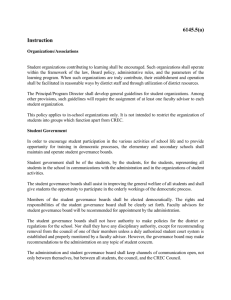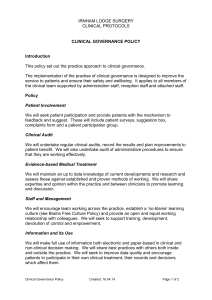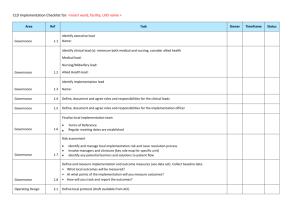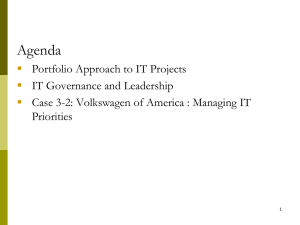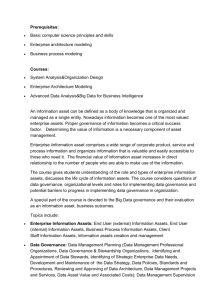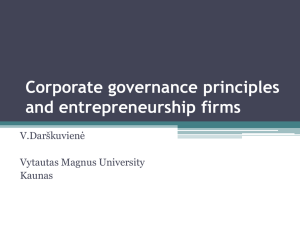Please click here for presentation materials
advertisement
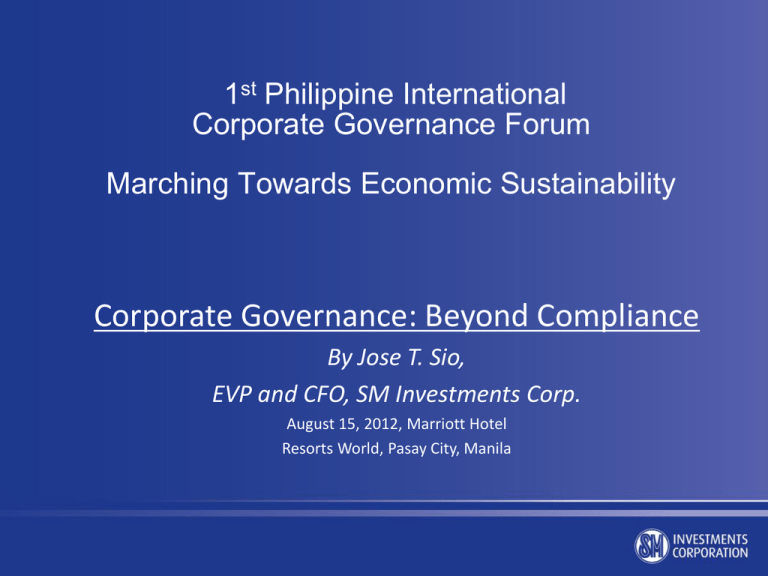
1st Philippine International Corporate Governance Forum Marching Towards Economic Sustainability Corporate Governance: Beyond Compliance By Jose T. Sio, EVP and CFO, SM Investments Corp. August 15, 2012, Marriott Hotel Resorts World, Pasay City, Manila Topic Road Map A. Evolution of Corporate Governance B. Corporate Governance in the Philippines C. Corporate Governance and Capital Markets A. Evolution of Corporate Governance: Wave of High Profile Scandals, Fraud, Crisis 1990s - CEO dismissals in the US (IBM, Kodak, etc.); Financial collapse of UK corporates (Polly Peck, Bank of Credit and Commerce Int’l, Maxwell Group,etc.) 1997 - Asian Financial Crisis 2000 - Massive bankruptcies and criminal malfeasance (Enron, Worldcom, AIG, AOL, Arthur Andersen, etc.) 2008 - US Sub-prime Crisis goes global 2011 - Greece crises and impacts Eurozone 2012 - JP Morgan’s “sloppy” deals, Barclays’ Libor-rigging scandal A. Reactions/Interventions to address crisis 1992 - The Cadbury Report issued. Defined Boards’ responsibilities and accounting systems. 2000 - OECD’s principles of corporate governance issued 2002 - Sarbanes and Oxley passed into law in the US 2008 - Bailouts of “too big to fail” corporates by governments e.g. Troubled Asset Relief Program in the US 2009 - Dodd-Frank Wall Street Reform and Consumer Protection Act Current - tighter monetary and financial policies, risk management 1st Conclusion: Crisis of Leadership B. Corporate Governance in the Philippines 2001 - World Bank & IMF Report: Corporate Governance Assessment of the Philippines based on OECD Principles • High concentration of wealth by limited number of families • Weak enforcement of corporate law and capital market regulations • Weak corporate boards • Need to professionalize accounting and auditing sectors • Poor disclosures of financial and non-financial information • Unprotected rights of minority shareholders B. SEC, PSE and BSP Response • SEC issued Corporate Governance Code in 2002, amended in 2009 • Required training and defined disqualifications of Directors • CG scorecard self-assessment issued and mandated • Required accreditation of external auditors, term of managing partner limited • Required setting up of various Board Committees • Imposed minimum of 2 independent directors in Boards • Required Audit Committees to Self-Assess Performance 2nd Conclusion: More Regulation vs. Enforced Regulation C. Corporate Governance and Capital Market 1) THE SM WAY -- RESPONSIBLE LEADERSHIP -- CASCADING THE CULTURE IN THE ENTIRE ORGANIZATION -- PARTNERS in BUSINESS a) Customers and Tenants b) Suppliers and Contractors c) Banks and creditors d) Our people e) Shareholders C. Corporate Governance and Capital Market 2) Building the business and our reputation -- revenues and income: growth path -- accessing the capital market: cost, size and term -- our share price: indication of trust Thank you.

